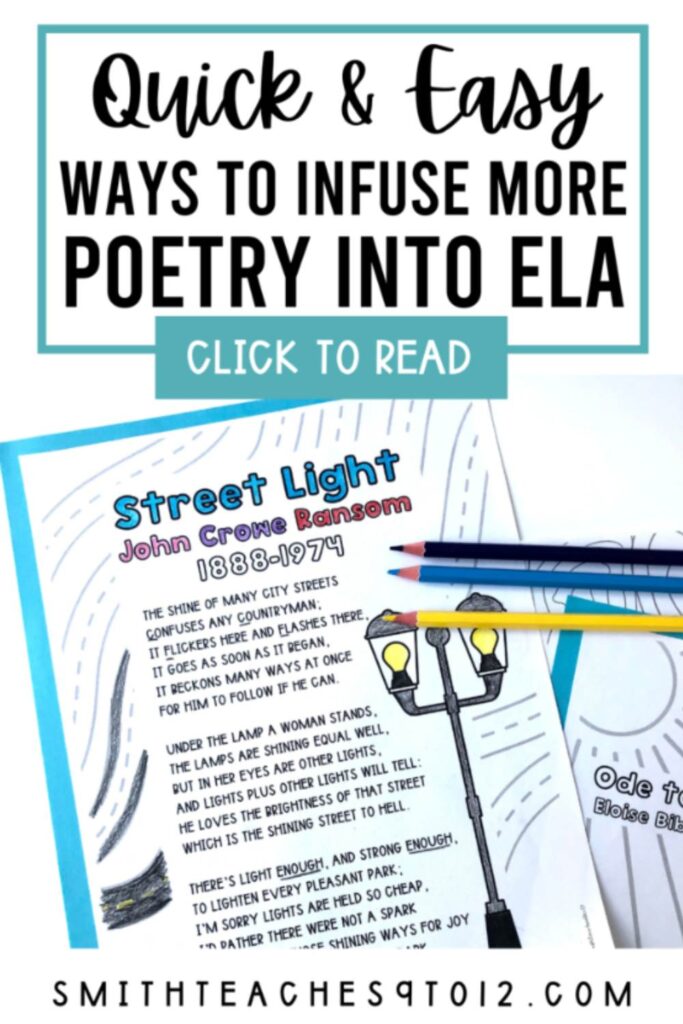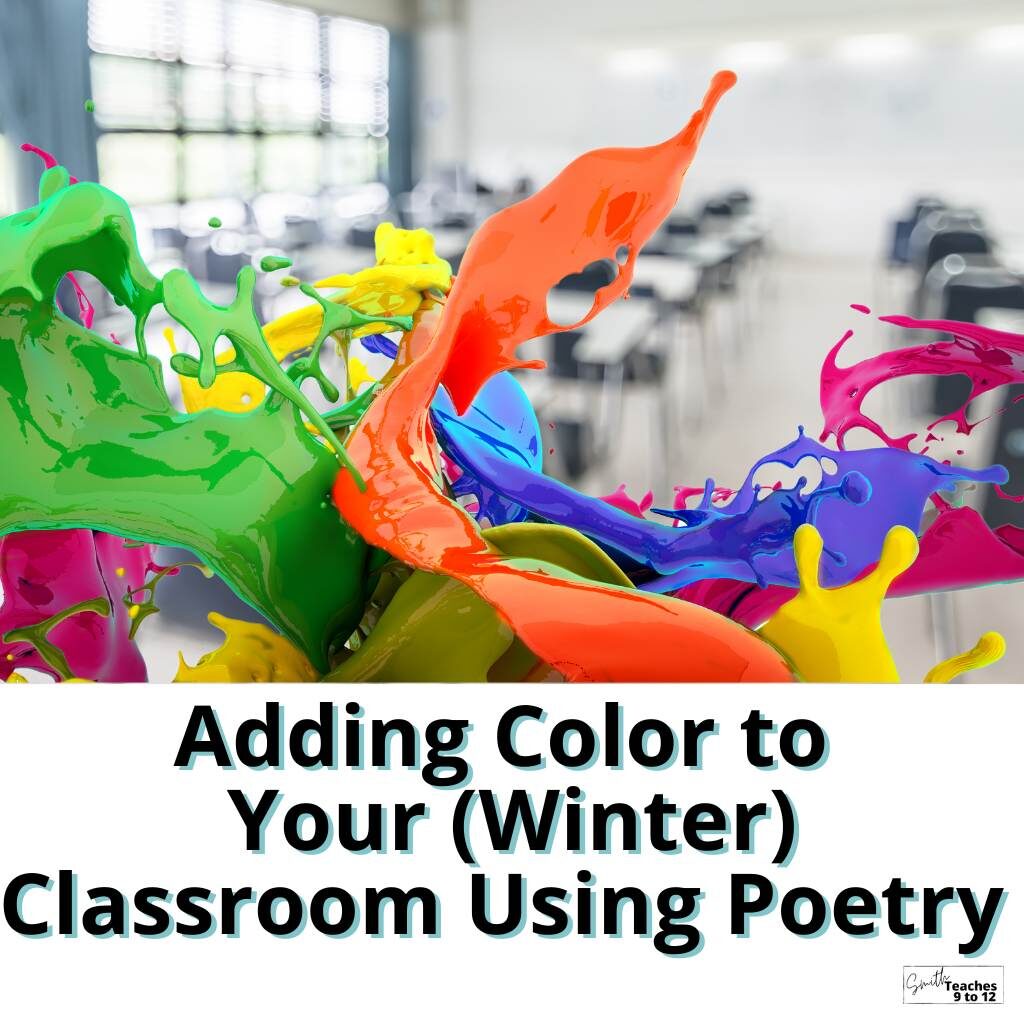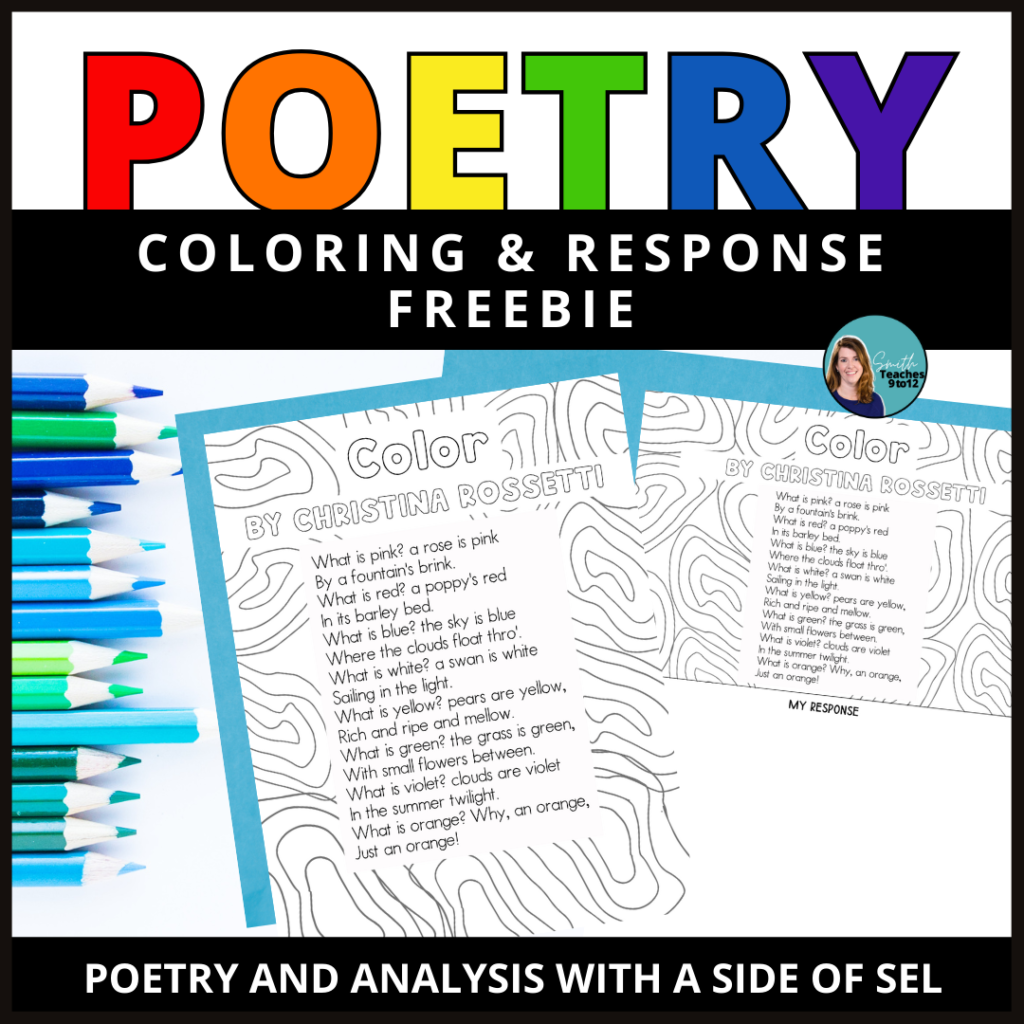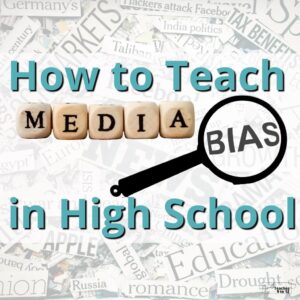Sharing is caring!
We are deep into winter and where I live the sun is only making occasional appearances. As we know, this lack of sun can take its toll on us as teachers and on our students too. To that end, I like to add some color into classroom activities using poetry; these small moments can brighten any mood while infusing a bit more poetry into the classroom.
These activities don’t have to fill a whole class period but could with the extended options included. They can be a quick 1-day activity as you shift from one unit to another or simply on a day when you know you and your students could use a bit of a stress-buster but still have some ELA content. I like to keep these as back-up elements in my emergency supply plans too!
Here are three ideas to add a bit of color to your ELA classroom in winter or any season at all.
Poems Featuring Colors as Mentor Texts
I love the work of Christina Rossetti and a lot of her work lends itself to a study in gothic poetry. You can check out more ideas for gothic poetry in this previous post about Spooky Season in ELA.
But Rossetti was fairly prolific and diverse in her subject matter so here’s an option that’s just too perfect not to include for any lesson about color and poetry. You can check out her short poem through this link: Color or see the full version included below.
To incorporate color and poetry, start with a reading and quick discussion of this Rossetti poem. Points you can discuss – how is this similar/different to other poetry you’ve read? What is the mood of the poem? Why might questions be used as a repetitive force in the poem? What about that closing line? You can use this FREEBIE response and coloring page to do just that!
You can then move into other color-focused poems such as
- Variations in Blue by Lauren K. Alleyne
- Green Means Literally A Thousand Things or More by Matt Donovan
- Blue by Carl Phillips
- Colors Passing Through Us by Marge Piercy
From here students can create their own color-focused poems. Incorporating idea one from this post with paint chips and the brainstorming option for keywords is one way to complete such poems in a group supported way.
Another idea is to simply have students pick a series of colors or colors from the same family (pink, hot pink, fuschia, rose, blush, etc.) to describe in a poem. It could follow Rossetti’s format with a question and answer. My class has had great success when stumped using the colors of the rainbow as a guide.
Extending Lessons with Non-Fiction Tie-Ins
With senior students I’ve used excerpts from The Secret Lives of Color by Kassia St. Clair to have them read a non-fiction piece of the origins and history of different colors and then use that to write a poem about the chosen color. With students in lower grades these excerpts could become color-out rather than blackout poetry by using a shade of the color featured in the write-up to cover up words and create poetry from the entry.
Another opportunity here is to design a lesson around an exploration of synesthesia. Students can read this background article from the American Psychological Association (APA) and complete a summary. If the article seems a bit too long or daunting for your students, consider a jigsaw set-up to get it done.
Using a Jigsaw technique for supported learning
If you’re not familiar, a jigsaw is when students are placed in two groups – one is a home group and one is an expert group. The expert group would all read and work together to summarize one section of the article. After they’ve completed an agreed upon summary they join their home group. In this home group they share their co-created summary from their expert group. In this way students only need to read one section but gain the knowledge of all three sections.
After completing the jigsaw students can incorporate the idea of synesthesia into their poem. What words/objects evoke what colors? Describe them. Make it poetic with interesting line breaks and punctuation, distinct rhyme and meter patterns, figurative language, tons of imagery, etc.
Poetry-Filled Coloring Pages – Stress Buster with an ELA Twist
There are days when my students, probably yours too, are just done. Either they’ve finished their work early and there’s not quite enough time to move to the next or that they’re figuratively done and the stress is high! If so, this is the moment where some poetry exposure and some old-fashioned coloring might be just the trick to decompress for a little bit.
I created 40 different pages of poetry with doodles to color. Students can read the poem and then bust out the crayons, markers, or colored pencils to escape a little into a low-stress activity. Click here to get a set for your students.
Now if you’d like to add a bit to this idea, there are also templates with the poem, doodles, and space for a response to the poem too. These were a really effective way for me to incorporate poetry more frequently into my classroom in a way that was low-stakes. These became bell ringers throughout the year – often on a Monday to ease into the week. Students read the poem and used one of 20 provided prompts to respond to the poem. This version is also included in the full set of Poetry Coloring Pages.

Paint Chip Poetry With Twists
A classic that can be done in a few different ways. The first step is to collect the supplies. You can collect paint chips or swatches from the store (make sure to get duplicates of the same ones in order to bring in some collaborative writing possibilities), find paper in different hues of the same color – scrapbook paper is a great option, or print an image featuring different hues/tones of a color. The works of artists such as Mark Rothko, Sheila Hicks, Shirazeh Houshiary, or Pat Steir would fit the bill.
If using paint chips with color names attached it could be that that color becomes the title of your poem and you describe the color in 5-8 lines. Then group together the lines by all students who have used the other colors on that same paint chip spectrum. (This is why duplicates of the same chips come in handy!) This is a way to create a collaborative poem.
If you find the larger paint chip/swatches then have students write directly onto those chips with 2-3 lines and group together a selection of colors to create a modified exquisite corpse poem.
If it’s different pieces of colored paper then have students brainstorm keywords that fit with that color – could be verbs, nouns, adjectives, short phrases even. Students can then use those brainstormed keywords to write a poem inspired by the color. Create this like a gallery with the color at the top of chart paper and put up around the room. Students can move about and add their keywords to the page and then circulate again to collect words for their own poems.
If it’s a painting or image then turn this into a lesson in ekphrastic poetry where students can turn the image into words in the form of a poem. This makes for a great display option too with the painting as a feature and the poems around them.
Whatever ideas you choose for your classroom I do hope they brighten things up a bit for you and your students. And if you try any of these ideas I’d love to hear about them! You can find me on Instagram or Pinterest to share with me and follow along in how I am making a big push for more poetry in my classroom this year!

Related articles
- Other ideas for using poetry during the year: 3 Ideas for Poetry Creation in Everyday ELA Lessons and Poetry Creation and Risk Taking in ELA






One Response